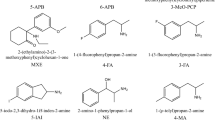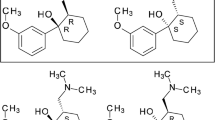Abstract
Capillary zone electrophoresis employing a dual cyclodextrin (CD) system, consisting of anionic sulfobutylether-β-CD and native β-CD, was developed for the simultaneous chiral separation of four H1-antihistamine racemates (brompheniramine, chlorpheniramine, cetirizine and promethazine). A cost-effective screening using different native and derivatized, neutral and ionized CDs as chiral selectors was performed to find suitable derivatives for the dual CD system. Under the optimized conditions consisting of 25 mM phosphate background electrolyte at pH 7.0, a combination of 15 mM SBE-β-CD and 10 mM β-CD as chiral selectors, +25 kV applied voltage and 20 °C system temperature, the baseline chiral separation of all racemates was accomplished in less than 8 min. The method proved to be suitable for routine analysis, since it provided satisfactory results during sensitivity, linearity and repeatability studies.



Similar content being viewed by others
References
Simons FER, Simons KJ (2011) Histamine and H1-antihistamines: celebrating a century of progress. J Allergy Clin Immunol 128:1139–1150
Mahdy AM, Webster NR (2014) Histamine and antihistamines. Anaesth Intensive Care Med 15:250–255
Casy AF, Drake AF, Ganellin CR et al (1992) Stereochemical studies of chiral H-1 antagonists of histamine: the resolution, chiral analysis, and biological evaluation of four antipodal pairs. Chirality 4:356–366
Haginaka J, Kagawa C (2004) Retentivity and enantioselectivity of uniformly sized molecularly imprinted polymers for d-chlorpheniramine and -brompheniramine in hydro-organic mobile phases. J Chromatogr B Analyt Technol Biomed Life Sci 804:19–24
Taha EA, Salama NN, Wang S (2009) Enantioseparation of cetirizine by chromatographic methods and discrimination by 1H-NMR. Drug Test Anal 1:118–124
Yuan LM, Liu JC, Yan ZH et al (2005) Enantioseparation of chlorpheniramine by high speed countercurrent chromatography using carboxymethyl-β-cyclodextrin as chiral selector. J Liq Chromatogr Relat Technol 28:3057–3063
Toribio L, del Nozal MJ, Bernal JL et al (2006) Study of the enantiomeric separation of oxfendazole and cetirizine using subcritical fluid chromatography on an amylose-based column. J Chromatogr A 1121:268–273
Gübitz G, Schmid MG (2004) Recent advances in chiral separation principles in capillary electrophoresis and and capillary electrochromatography. Electrophoresis 23:3981–3996
Stavrou IJ, Mavroudl MC, Kapnissi-Christodoulou CP (2015) Chiral selectors in CE: recent developments and application. Electrophoresis 36:101–123
Szente L, Szemán J (2013) Cyclodextrins in analytical chemistry: host-guest type molecular recognition. Anal Chem 85:8024–8030
Chankvetadze B, Lindner W, Scriba GKE (2004) Enantiomer separations in capillary electrophoresis in the case of equal binding constants of the enantiomers with a chiral selector: commentary on the feasibility of the concept. Anal Chem 76:4256–4260
Escuder-Gilabert L, Martín-Biosca Y, Medina-Hernández MJ, Sagrado S (2014) Cyclodextrins in capillary electrophoresis: recent developments and new trends. J Chromatogr A 1357:2–23
Rezanska P, Navratilova K, Rezanska M, Kral V, Sykora D (2014) Application of cyclodextrins in chiral capillary electrophoresis. Electrophoresis 35:2701–2721
Chankvetadze B, Endresz G, Blaschke G (1996) Charged cyclodextrin derivatives as chiral selectors in capillary electrophoresis. Chem Soc Rev 25:141–153
Müllerová L, Dubsky P, Gas B (2014) Twenty years of development of dual and multi-selector models in capillary electrophoresis: a review. Electrophoresis 35:2688–2700
Otsuka K, Terabe S (1993) Optical resolution of chlorpheniramine by cyclodextrin added capillary zone electrophoresis and cyclodextrin modified micellar electrokinetic chromatography. J Liq Chromatogr 16:945–953
Chankvetadze B, Burjanadze N, Pintore G et al (2000) Separation of brompheniramine enantiomers by capillary electrophoresis and study of chiral recognition mechanisms of cyclodextrins using NMR-spectroscopy, UV spectrometry, electrospray ionization mass spectrometry and X-ray crystallography. J Chromatogr A 875:471–484
Ho Y-H, Wu H-L, Wu S-M et al (2003) Quantitative enantiomeric analysis of chlorcyclizine, hydroxyzine, and meclizine by capillary electrophoresis. Anal Bioanal Chem 376:859–863
Mikus P, Valásková I, Havránek E (2005) Enantioselective determination of pheniramine in pharmaceuticals by capillary electrophoresis with charged cyclodextrin. J Pharm Biomed Anal 38:442–448
Chou Y-W, Huang W-S, Ko C-C, Chen S-H (2008) Enantioseparation of cetirizine by sulfated-beta-cyclodextrin-mediated capillary electrophoresis. J Sep Sci 31:845–852
Jin Y, Stalcup AM (1998) Application of heparin to chiral separations of antihistamines by capillary electrophoresis. Electrophoresis 19:2119–2123
Gagyi L, Gyéresi A, Kilár F (2006) Role of chemical structure in stereoselective recognition of beta-blockers and H1-antihistamines by human serum transferrin in capillary zone electrophoresis. Electrophoresis 27:1510–1516
Martínez-Gómez MA, Sagrado S, Villanueva-Camañas RM, Medina-Hernández MJ (2007) Enantiomeric quality control of antihistamines in pharmaceuticals by affinity electrokinetic chromatography with human serum albumin as chiral selector. Anal Chim Acta 592:202–209
Nojavan S, Fakhari AR (2011) Chiral separation and quantitation of cetirizine and hydroxyzine by maltodextrin-mediated CE in human plasma: effect of zwitterionic property of cetirizine on enantioseparation. Electrophoresis 32:764–771
Cui Y, Ma X, Zhao M et al (2013) Combined use of ionic liquid and hydroxypropyl-β-cyclodextrin for the enantioseparation of ten drugs by capillary electrophoresis. Chirality 25:409–414
La S, Kim J, Kim JH, Goto J, Kim KR (2003) Simultaneous chiral discrimination of multiple profens by cyclodextrin-modified capillary electrophoresis in normal and reversed polarity modes. Electrophoresis 24:2642–2649
Chu BL, Guo B, Zuo H, Wang Z, Lin JM (2008) Simultaneous enantioseparation of antiparkinsonian medication Rotigotine and related chiral impurities by capillary zone electrophoresis using dual cyclodextrin system. J Pharm Biomed Anal 46:854–859
Marosi A, Kovács Z, Béni S et al (2009) Triprotic acid-base microequilibria and pharmacokinetic sequelae of cetirizine. Eur J Pharm Sci 37:321–328
Desiderio C, Fanali S (1995) Use of negatively charged sulfobutyl ether-β-cyclodextrin for enantiomeric separation by capillary electrophiresis. J Chromatogr A 716:183–196
Skanchy DJ, Xie GH, Tait RJ et al (1999) Application of sulfobuthyl ether-β-cyclodextrin with specific degree of substitution for the enantioseparation of pharmaceutical mixtures by capillary electrophoresis. Electrophoresis 20:2638–2649
Lurie IS, Klein RF, Dal Cason TA et al (1994) Chiral resolution of cationic drugs of forensic interest by capillary electrophoresis with mixtures of neutral and anionic cyclodextrin. Anal Chem 66:4019–4026
European Pharmacopoeia (2014), 8th edn. Council of Europe, Strasbourg
Servais AC, Fillet M (2013) Application of dual cyclodextrin systems in capillary electrophoresis enantioseparations. Methods Mol Bio 970:289–295
Acknowledgments
This paper was published under the frame of European Social Fund, Human Resources Development Operational Programme 2007-2013, project no. POSDRU/159/1.5/S/136893. The first author would like to thank Collegium Talentum for their financial support.
Author information
Authors and Affiliations
Corresponding author
Ethics declarations
Conflict of interest
The authors report no conflicts of interest. The authors alone are responsible for the content and writing of the paper.
Rights and permissions
About this article
Cite this article
Szabó, ZI., Tóth, C., Hancu, G. et al. Simultaneous Chiral Separation of Four H1-Antihistamines by Capillary Zone Electrophoresis Using a Dual Cyclodextrin System. Chromatographia 78, 1377–1384 (2015). https://doi.org/10.1007/s10337-015-2967-y
Received:
Revised:
Accepted:
Published:
Issue Date:
DOI: https://doi.org/10.1007/s10337-015-2967-y




